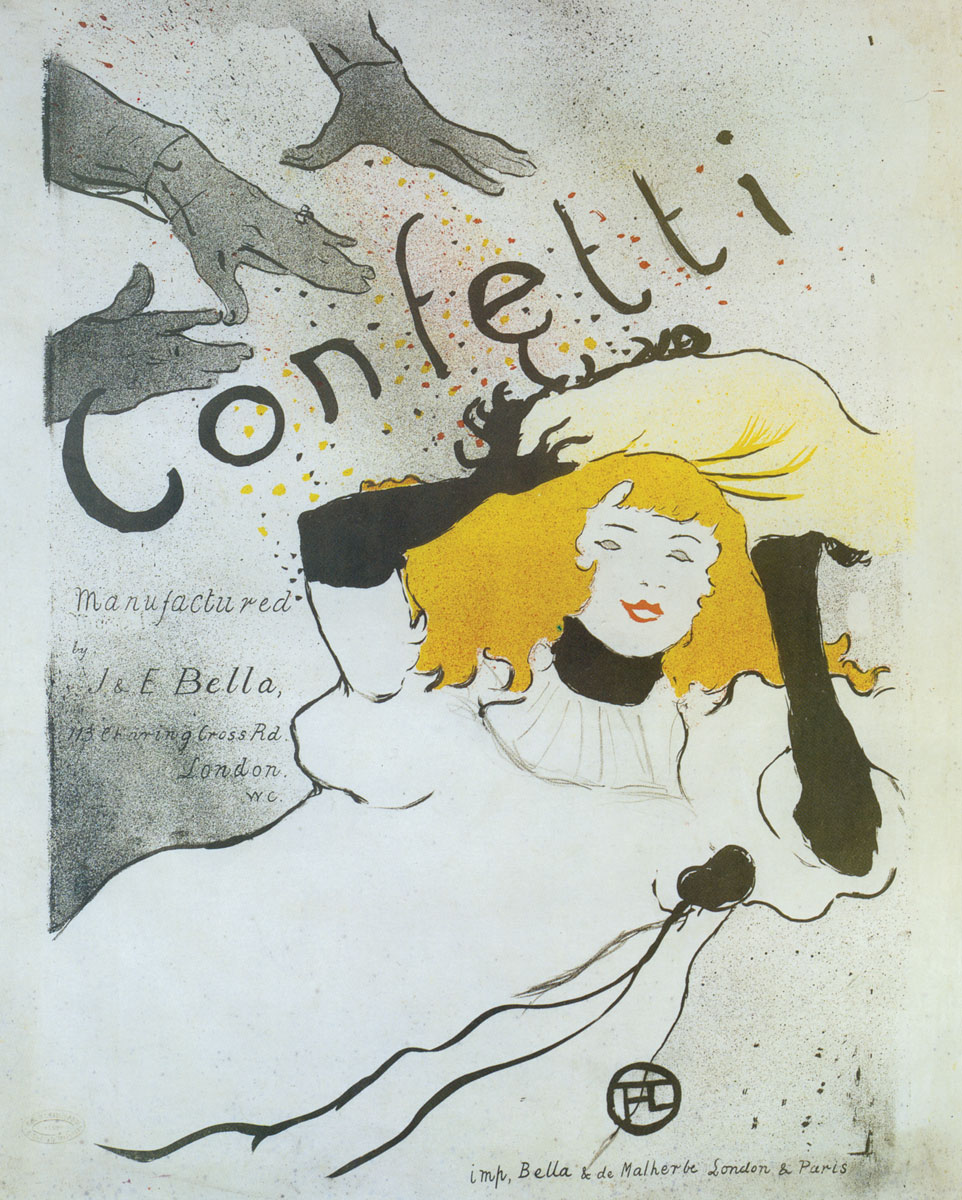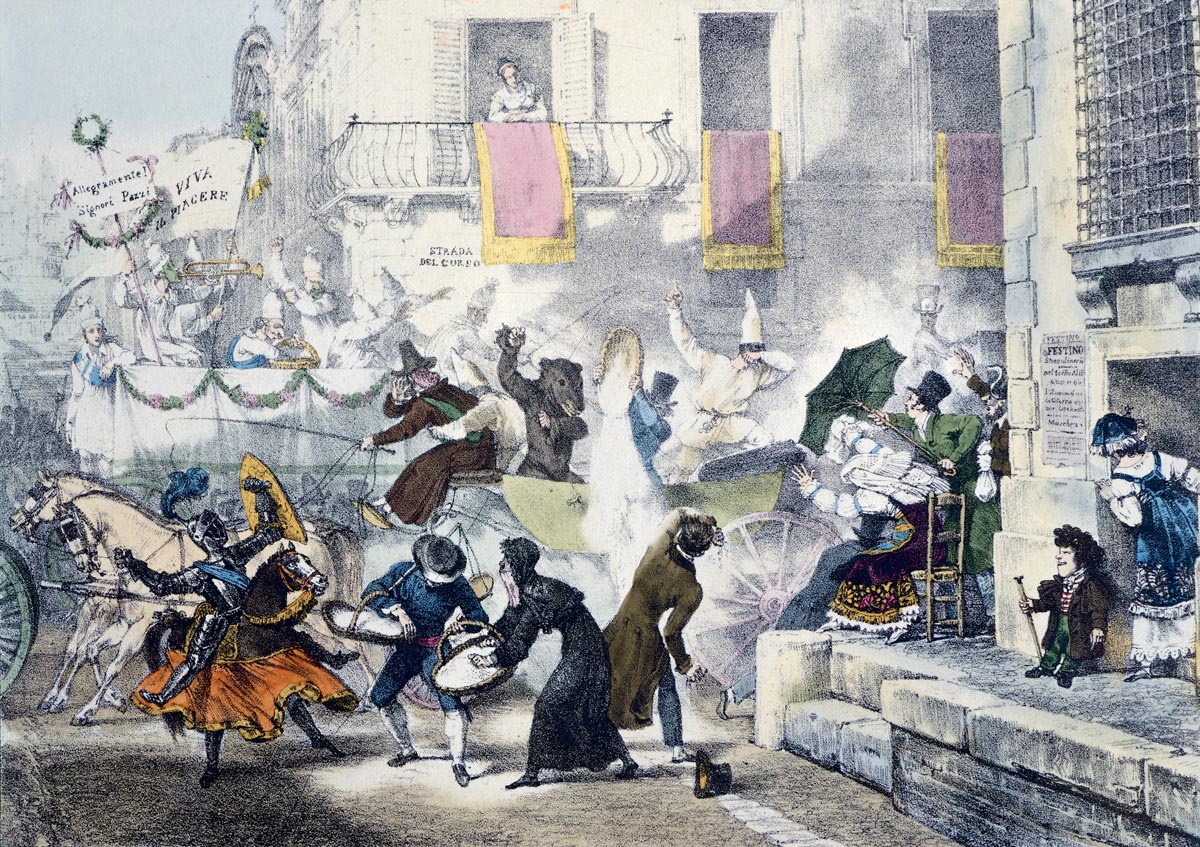Confetti Uncut
From phyllobolia to Carnevale
D. Graham Burnett
In a park I once watched a small boy attempting to feed shelled peanuts to a cautious squirrel. The boy squatted on his haunches, and held forth an open hand: “Here!” he offered with ingenuous sweetness. The squirrel took a hop in his direction, twitching its bushy tail nervously. “Here, eat them,” the boy encouraged, his voice just above a whisper. The squirrel drew a little closer, carefully eyeing the hand and the nuts and the squatting boy. “Eat them!” the boy said again after a pause, a little louder this time—but the scene did not change. And there they stayed, in a taut tableau, until, suddenly, the boy, overcome by love and generosity and other things, sprang to his feet and leapt forward in pursuit of the squirrel, now streaking for the nearest tree. “Eat them! Eat them!” he cried as he ran, wild-eyed, flinging the nuts before him.
• • •
Phyllobolia refers to the ancient Greek custom of throwing branches, leaves, garlands, or other plant matter (sometimes barley, flowers, or fruit) over, onto, or before a person—generally in celebratory reverence. The tradition is most closely associated with three quite different situations: 1) public ceremonies of honor, such as the triumph of a soldier, politician, or athlete; 2) internment or funerary rituals; 3) weddings. While it is not unknown for colorful petals or nosegays to appear in association with phyllobolia, the canonical form of the ritual makes use of more or less worthless clippings of greenery, not refined offerings of flowers or edibles. What was cast was not, traditionally, gathered up or saved. It was trodden underfoot.
• • •
Classicists, folklorists, and anthropologists have sparred over the origin and meaning of phyllobolia. So, for instance, some will have it that the practice evolved out of traditions of gift giving. There is something plausible, even intuitive, about this genealogy. You might wish to lay a leafy crown on the brow of a young sprinter, but the press of the crowd or his own fleetness of foot might make this impossible. Quite possibly the best you could manage would be to launch your laurel snippings in his direction. He is out of reach, moving on. Similarly, the newlyweds are headed away together. And the dead have very definitely left us behind. Perhaps, then, the handfuls thrown in these directions say, “I can’t reach you, but I am trying…”

• • •
An alternative account, however, is associated with the great German scholar of archaic cults, Walter Burkert, and his masterwork Homo Necans (i.e., “Man the Killer”). Reconstructing the ritual choreography of primitive sacrifice, Burkert drew attention to the widespread gesture of throwing plant material (often seeds or kernels of grain) on a victim—lamb, calf, bird, luckless captive—just before the knife fell. A gift? Perhaps not. Rather, Burkert saw sublated violence, much closer to the warm-up for a stoning: “The act of throwing together as a group is an aggressive gesture, like beginning a fight, even if the most harmless projectiles are chosen.” Why, in his view, had such ambivalent stuff-sprinkling rites arisen among so many primitive tribes? Because group killing—both warfare and hunting—was the sine qua non of survival, and Burkert thought it took some doing to goad Homo sapiens to the pitch necessary for such work. (He seems to have believed that protohumans were mellow vegetarians.) Throwing together was thus a good place to start the requisite crescendo of collective aggression that constellated human communities, guaranteed their continuity, and permitted some of them (and not others) to leave the marks called history. By these lights, phyllobolia always also said, “We are thinking about killing you.”
• • •
In the 1980s, professional athletes in the United States initiated a charivari tradition of “coach dunking” (a.k.a. “the Gatorade Shower”), in which team captains or respected players would, on the expiration of the clock in an important win, douse their leader with the contents of a large cooler. This saturnalian “baptism” now consistently marks the start of the victory celebrations at the close of a big game. Watching the tape of exuberant defensive tackle Jim Burt drenching Bill Parcells at the two-minute warning of the New York Giants’ 37–13 win over the Washington Redskins in late October of 1984 (arguably the origin of the modern practice), it is difficult not to think of the other key aspect of sacrificial ritual upon which Burkert expended his interpretive energies: namely, the sudden shower of water visited on the head of a beast about to be slain for the gods. The reflexive recoil occasioned by this splash—the glimpse up (to see what’s coming), and then the ducking down (to avert the face and eyes)—signified richly in Burkert’s account: “The animal’s movement here is taken to signify a ‘willing nod,’ a ‘yes’ to the sacrificial act,” he explained, an assertion he buttressed with citations to Aristophanes, Plutarch, and similarly significant classical sources. Sometimes, it turns out, flinching is a kind of assent.
• • •
On 27 November 2010, the Michigan State Spartans football team carefully prepared a cooler full of green and white confetti (the team’s colors) with which they anointed coach Mark Dantonio at the conclusion of their Big-Ten-clinching 28-22 victory over Penn State at Happy Valley. This striking convergence of the traditionally distinctive phases of sacrificial ritual—baptismós and phyllobolia—was occasioned by collective concern about Dantonio’s health (he had been hospitalized for a heart attack and complications in the months preceding the game). A few weeks later, the Spartans were crushed 49-7 by Alabama’s “Crimson Tide” in the Capital One Bowl on New Year’s Day, but Dantonio emerged unharmed. The team did not kill him, eat his heart and thighs, and then immolate his other remains on a towering altar erected at midfield.
• • •
Still, it is by no means clear that structural-functional psycho-mythographies of ancient chaff hurling do much to advance a proper history of modern confetti. Sure, one can easily shiver in a wedding chapel, sensing—as rice rains on ducking tenderness and gravels the nuptial path—that the ghost of phyllobolia haunts the proceedings. Palm Sunday too, can bring a twinge. And yes, the learned ethnographer, pelted with powdered pigments in the streets of Jaisalmer during the festival of Holi (the bright dusts were once prepared from ground turmeric seeds, and the pulverized leaves of neem and dhak trees), may muse on the funeral pyre that consumed the evil demon demigodess Holika, after whom the occasion is named. And true, true, a sensitive poet can certainly feel, as the glitter descends on New Year’s Eve, that there is more than a little of Jupiter’s encounter with Danaë in the dropping sparkle-dust. But the disciplined historical thinker, the true historicist, will always be impatient with nebulous invocations of nebulous atavisms. We should try to be precise—even about the showers of polychrome chad we toss in glee.
• • •
Throwing confetti is not an exact science, and neither is philology. But the latter comes closer. Confetti hails from the Latin past participle of conficere, meaning “to prepare or make ready.” Passed through Old French, the root word took on the sense of “preserving”—hence the French confit and confiture, meaning, respectively, “preserved meat” and “preserved fruit,” i.e., jam. In the wake of the discovery of the New World and the intensive cultivation of sugar cane on slave plantations in the tropical Americas, the dominant meaning of confit and its pan-European cognates came to be candying—cooking in sugar. Confetti, in eighteenth-century Italian, thus meant “little sweets,” the kind of thing an Englishman might call a “sugarplum,” which is to say, small balls of confect-ionary. Sometimes these consisted of a mince of candied fruit (often encased in a sugar shell—powdered, granulated, panned), and sometimes they were built like a jawbreaker around a kernel of seed (anise, coriander, etc.) or a nut (like what we now call a “Jordan almond”). These were things that could be thrown.
• • •
Here is a young Englishwoman, Anna Brownell Jameson, describing an extravagant afternoon on Naples’s Strada di Toledo in her Diary of an Ennuyée (1826):
Among our most potent and malignant adversaries, was a troop of elegant masks in a long open carriage, the form of which was totally concealed by the boughs of laurel, and wreaths of artificial flowers with which it was covered. … They were armed with small painted targets and tin tubes, from which they shot vollies of confetti in such quantities and with such dexterous aim, that we were almost overwhelmed whenever we passed them. It was in vain we returned the compliment; our small shot rattled on their masks, or bounded from their shields, producing only shouts of laughter at our expense.The occasion? Carnevale, the madcap street festivals that traditionally precede Ash Wednesday and the forty-day fasting season called Lent—the preparation for the paschal sacrifice known as Easter.

• • •
The history of confetti is inextricable from the history of Carnevale in Italy across the long nineteenth century. Indeed, the term itself is first used in English in its modern sense—i.e., in connection with the business of tossing little bits of stuff at people under conditions of ostensibly celebratory goodwill—by cosmopolitan English aristocrats (and a few moneyed Americans) writing about their Grand Tours. Picturesque accounts of carnival masquerades and, above all, the “ridiculous warfare” of the sugarplums took pride of place in dozens of gazetteers, guidebooks, and personal narratives published between 1820 and 1850. “The chief amusement of the Carnival consists in throwing the confetti,” explained the author of The Continental Traveller’s Oracle in 1828. Similar texts advised tourists on the etiquette of the combat (one should be aware that superstitions attached to the eating of a missile lobbed by a member of the opposite sex), the dangers (masks, known as par à bonbons, were not merely for zesty peekaboo, they were de rigueur to protect against eye injury, and the cognoscenti also avoided wearing good hats), and, of course, the weaponry. The British entomologist and numismatist H. Noel Humphreys dilated on the latter in his Rome, and Its Surrounding Scenery:
The sharpest engagements took place under a balcony occupied by Prince C , with some English companions, and a party of French; they had an immense supply of confetti, and each time a carriage of friends passed beneath … they were greeted with a few pounds of sugar plumbs [sic], emptied from a large soup-plate, or projected from a tin engine somewhat resembling a huge extinguisher; whilst the sharpest discharge was from a kind of sling, formed of a piece of whalebone about eighteen inches in length, to the end of which is affixed a sort of spoon, or rather ladle, which being drawn back until the handle is nearly double, and suddenly let go, discharges the missiles with almost the force and precision of Perkins’s gun.
• • •
The story of confetti across the nineteenth century turns out to be a story of sequential dilapidations and displacements that, taken together, concisely epitomize the social, political, religious, and economic trajectories of European modernity. For starters, it should be recalled that sugar was very much a luxury item in the late eighteenth century, closely associated with the aristocracy. It would be difficult to produce a better example of ancien régime extravagance than fancy-ball follies in which bucketfuls of costly sweets were wantonly tossed to the parquet by flirting nobles. That the occasions travestied military combat perfectly résumés the fatal decadence of the knightly class—whose elite status nominally derived from martial duties and martial capacities. To top it off, Carnevale, prelude to religious fasts and high holy days, was integrally bound to the ecclesiastical calendar, and as such represented the imbrication of Church and Court that lay at the foundation of premodern political order. Little wonder, then, that Carnevale became a battleground for all the forces—radical, reactionary, republican—clawing for control in the wake of the French Revolution and its Napoleonic aftershocks. The changing character of confetti itself tells much of the story: by the early 1830s, when the American physician Dr. Joseph Togno dodged handfuls of “confetti” in the chaotic streets of carnival Rome, he could hardly find an actual confetto—instead, fake bonbons made of plaster of paris lay deep as New Hampshire snow in the gutters, and ragged urchins raked them up in baskets to resell for pennies to drunken revelers. It was a far cry from the rustling silk and luxe sweetmeats of a bygone age. Moreover, contemporary commentators noted, it was only populist agitation in the wake of the revolutions of 1830 that had forced the beleaguered new pope, Gregory XVI, to relent on the bans that the Vatican had tried to place on Carnevale over the previous decade (conservatives felt the whole thing was getting out of control—too secular, and it reeked of the rabble). Here is one wry take, by an anonymous liberal writing in the Athenaeum in 1834, on Pope Gregory’s circus sop to the Italian masses:
His Holiness, good papa as he is, gave in to it. Had he persisted in obliging his children to play all-fools in moderation, they would have turned march-of-intellect people before he could whistle a semiquaver. … But this year they have had a Bull of permission, and per Bacco! ... all notions of civil and ecclesiastic reform, which had begun to sprout under his Sanctity’s nose, were nipped by the indulgence.Hurling ersatz confetti at each other in a grubby sham of court pageantry, the urban proles made tragic sport of their revolutionary power. Unless, perhaps, they were learning to throw together.

• • •
Best to give them something absolutely harmless to heave. Which brings us to the apotheosis of simulacral confetti. In the winter of 1875, the proprietor of a successful textile mill in Milan, one Enrico Mangili, hit upon a clever use for a peculiar refuse generated by his factory. It happens that commercial silkworms—inbred for millennia—have some difficulty extricating themselves from their eggs; this can create problems in larval development. To assist, industrial sericulturists long ago hit upon using large sheets of paper, punched with numerous small holes of a size that admitted only the body of the hatching worm. Placed over the egg trays, these sheets functioned to strip the sticky shell from the back end of the wriggling wormlets as they made their way, by smell, toward the mulberry leaves on which they would feed for the whole of their brief lives. Detesting waste (he trained as an engineer), and philanthropically inclined (as any grand bourgeois gentleman should be), il Cavalier Mangili spotted efficiency and safety (and possibly a supplementary revenue stream) in the innumerable dischetti perforated from those sheets. And voilà: paper confetti was thrown for the first time in human history at the Carnevale of Milan in 1875—revels that followed close on the heels of Italian unification. These novel fistfuls of paper, thrown by parading merrymakers under a flapping tricolore, thus complete the dynamics of bourgeois counter-revolution in that century, whereby gaudy rubbish (the byproduct of capitalist accumulation) was retailed back to workers, who celebrated therewith, in collective rituals that borrowed liberally from religio-aristocratic forms, their suicidal devotion to the rising bitch-god of nationalism.
• • •
Confetti: Tinsel meth of the masses. Paper shrapnel. A phyllobolia of trash, scattered over those to be sacrificed in the twentieth century.
See press about “Confetti Uncut” on Arts & Letters Daily.
D. Graham Burnett is an editor of Cabinet and teaches at Princeton University. Currently a Guggenheim Fellow at the Bard Graduate Center in Manhattan, he recently helped prepare a portion of the Rülek Scrolls for use in the “Age of Practices,” a curatorial project at the Palais de Tokyo, Paris.
Spotted an error? Email us at corrections at cabinetmagazine dot org.
If you’ve enjoyed the free articles that we offer on our site, please consider subscribing to our nonprofit magazine. You get twelve online issues and unlimited access to all our archives.